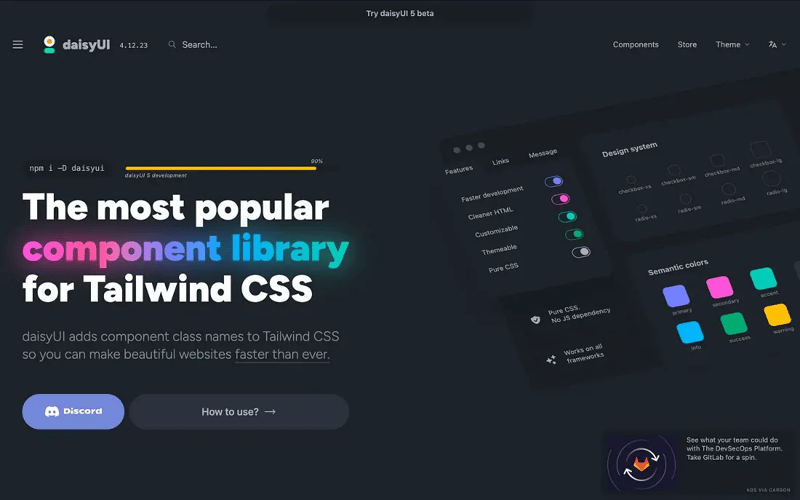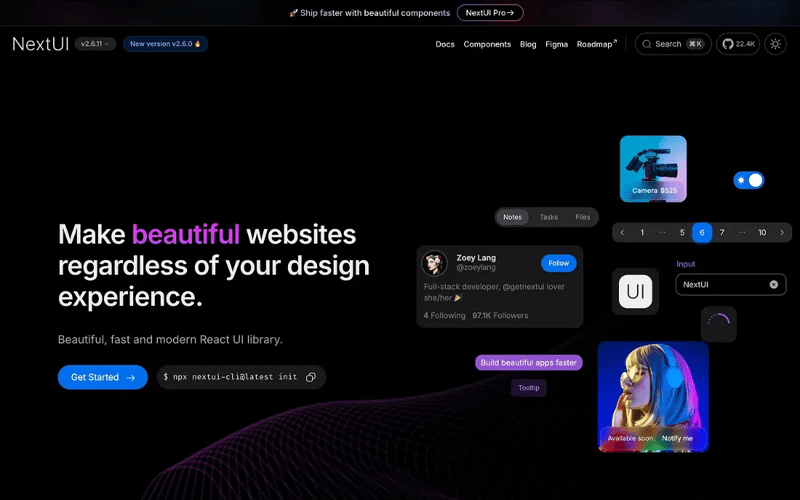Top I Component Libraries for Copy, Paste, and Create!
Top 7 Copy-and-Paste UI Component Libraries for 2025
We've rigorously tested numerous copy-and-paste UI component libraries and selected our top seven for 2025. These libraries excel in ease of use, flexibility, scalability, customization, and built-in animations. Ready to revolutionize your design workflow? These libraries provide everything you need for sleek, modern interfaces.

1. DaisyUI: Your Tailwind CSS Design System

DaisyUI, a versatile open-source library, transforms Tailwind CSS into a comprehensive design system. It boasts pre-styled components and themes for effortless design implementation.
Key Features:
- Built-in Themes: Rapid style adaptation.
- Ready-Made Components: Buttons, modals, forms, and more are readily available.
- Customizable: Tailor designs using Tailwind's utility classes.
Ideal For: Responsive layouts, dark mode integration, and UI element customization—perfect for blogs and simple web apps. DaisyUI simplifies design without compromising quality.
2. UIverse: The Pinterest of UI Components

UIverse provides a Pinterest-like experience for discovering UI components. It offers beautifully designed, ready-to-use elements, including glowing buttons and stylish progress bars.
Key Features:
- Curated Components: A handpicked selection of visually appealing UI elements.
- Eye-Catching Effects: Floating cards, hover effects, and glowing buttons for a modern aesthetic.
- Quick Setup: Simply copy and paste—no complex setup required.
Ideal For: Visually stunning dashboards and applications where aesthetics are paramount, such as project management tools. UIverse adds polish and style with minimal effort.
3. Float UI: Simplicity and Functionality

Float UI prioritizes simplicity and functionality. This free UI library offers pre-designed components, from hero sections to pricing tables, saving you valuable time and effort.
Key Features:
- Time-Saving: Ready-made, fully styled components.
- Minimalistic Design: Clean, modern UI elements without unnecessary clutter.
- Customizable: Easily tweak with Tailwind CSS to match your brand.
Ideal For: Launching SaaS products or creating elegant landing pages. Float UI's pre-designed elements allow for rapid professional page creation, while Tailwind enables seamless brand customization.
4. Shadcn UI: The Customizable Foundation

Shadcn UI, often hailed as a top choice, is built on Radix and Tailwind CSS, emphasizing scalability and complete customization.
Key Features:
- Scalable & Customizable: Perfect for building bespoke UI libraries.
- Accessibility-Focused: Pre-designed, accessible modals, buttons, and more.
- Tailwind-Friendly: Effortless integration with Tailwind CSS for styling.
Ideal For: Creating custom component libraries for large-scale projects, such as e-commerce platforms. Shadcn UI allows for the development of accessible, reusable components that scale with your project's growth.
5. Aceternity: Animation and Visual Flair

Aceternity seamlessly integrates with Framer Motion to provide beautifully animated components, adding visual dynamism to your projects.
Key Features:
- Visually Stunning: Polished animations and effects for an enhanced user experience.
- Animation-Focused: Ideal for creating engaging, interactive elements.
- Seamless Integration: Works smoothly with Framer Motion for fluid animations.
Ideal For: Enhancing product marketing pages or startup websites. Aceternity's animated elements create a captivating user experience.
6. Magic UI: Adding Spice to Your Website

Magic UI, built on ShadCN, offers over 50 animated components to elevate your designs.
Key Features:
- Highly Animated: Over-the-top 3D effects and interactive components.
- Creative Flair: Adds a "wow" factor with unique animations.
- Pre-Assembled Templates: Magic UI Pro includes stunning, ready-to-use templates.
Ideal For: Creative portfolios and dynamic SaaS landing pages. Magic UI's animations create a memorable user experience.
7. Next UI: A Comprehensive Design System

Next UI is a complete design system, not just a component library. Built for Next.js, it provides over 210 plug-and-play components for creating polished, scalable applications.
Key Features:
- Full Design System: Includes tools for both design and development.
- Optimized for Next.js: Seamless integration and server-side rendering for high performance.
- Comprehensive Components: Forms, data tables, modals, navigation bars, and more.
Ideal For: Developing large-scale applications like enterprise dashboards. Next UI's responsive components and Figma kit facilitate efficient collaboration between developers and designers.
Choosing the Right Library
Selecting the ideal library depends on project size, design requirements, and framework compatibility. Consider the following:
- Project Size: Smaller projects benefit from libraries like Float UI and Aceternity, while larger projects require scalable systems like Next UI.
- Design Requirements: Choose Aceternity or Magic UI for animations; DaisyUI or UIverse for minimalist designs.
- Framework Compatibility: Ensure compatibility with your chosen framework (React, Vue, Svelte, or HTML).
Connect with me on LinkedIn! ?
The above is the detailed content of Top I Component Libraries for Copy, Paste, and Create!. For more information, please follow other related articles on the PHP Chinese website!

Hot AI Tools

Undresser.AI Undress
AI-powered app for creating realistic nude photos

AI Clothes Remover
Online AI tool for removing clothes from photos.

Undress AI Tool
Undress images for free

Clothoff.io
AI clothes remover

Video Face Swap
Swap faces in any video effortlessly with our completely free AI face swap tool!

Hot Article

Hot Tools

Notepad++7.3.1
Easy-to-use and free code editor

SublimeText3 Chinese version
Chinese version, very easy to use

Zend Studio 13.0.1
Powerful PHP integrated development environment

Dreamweaver CS6
Visual web development tools

SublimeText3 Mac version
God-level code editing software (SublimeText3)

Hot Topics
 1664
1664
 14
14
 1422
1422
 52
52
 1316
1316
 25
25
 1266
1266
 29
29
 1239
1239
 24
24
 Demystifying JavaScript: What It Does and Why It Matters
Apr 09, 2025 am 12:07 AM
Demystifying JavaScript: What It Does and Why It Matters
Apr 09, 2025 am 12:07 AM
JavaScript is the cornerstone of modern web development, and its main functions include event-driven programming, dynamic content generation and asynchronous programming. 1) Event-driven programming allows web pages to change dynamically according to user operations. 2) Dynamic content generation allows page content to be adjusted according to conditions. 3) Asynchronous programming ensures that the user interface is not blocked. JavaScript is widely used in web interaction, single-page application and server-side development, greatly improving the flexibility of user experience and cross-platform development.
 The Evolution of JavaScript: Current Trends and Future Prospects
Apr 10, 2025 am 09:33 AM
The Evolution of JavaScript: Current Trends and Future Prospects
Apr 10, 2025 am 09:33 AM
The latest trends in JavaScript include the rise of TypeScript, the popularity of modern frameworks and libraries, and the application of WebAssembly. Future prospects cover more powerful type systems, the development of server-side JavaScript, the expansion of artificial intelligence and machine learning, and the potential of IoT and edge computing.
 JavaScript Engines: Comparing Implementations
Apr 13, 2025 am 12:05 AM
JavaScript Engines: Comparing Implementations
Apr 13, 2025 am 12:05 AM
Different JavaScript engines have different effects when parsing and executing JavaScript code, because the implementation principles and optimization strategies of each engine differ. 1. Lexical analysis: convert source code into lexical unit. 2. Grammar analysis: Generate an abstract syntax tree. 3. Optimization and compilation: Generate machine code through the JIT compiler. 4. Execute: Run the machine code. V8 engine optimizes through instant compilation and hidden class, SpiderMonkey uses a type inference system, resulting in different performance performance on the same code.
 Python vs. JavaScript: The Learning Curve and Ease of Use
Apr 16, 2025 am 12:12 AM
Python vs. JavaScript: The Learning Curve and Ease of Use
Apr 16, 2025 am 12:12 AM
Python is more suitable for beginners, with a smooth learning curve and concise syntax; JavaScript is suitable for front-end development, with a steep learning curve and flexible syntax. 1. Python syntax is intuitive and suitable for data science and back-end development. 2. JavaScript is flexible and widely used in front-end and server-side programming.
 JavaScript: Exploring the Versatility of a Web Language
Apr 11, 2025 am 12:01 AM
JavaScript: Exploring the Versatility of a Web Language
Apr 11, 2025 am 12:01 AM
JavaScript is the core language of modern web development and is widely used for its diversity and flexibility. 1) Front-end development: build dynamic web pages and single-page applications through DOM operations and modern frameworks (such as React, Vue.js, Angular). 2) Server-side development: Node.js uses a non-blocking I/O model to handle high concurrency and real-time applications. 3) Mobile and desktop application development: cross-platform development is realized through ReactNative and Electron to improve development efficiency.
 How to Build a Multi-Tenant SaaS Application with Next.js (Frontend Integration)
Apr 11, 2025 am 08:22 AM
How to Build a Multi-Tenant SaaS Application with Next.js (Frontend Integration)
Apr 11, 2025 am 08:22 AM
This article demonstrates frontend integration with a backend secured by Permit, building a functional EdTech SaaS application using Next.js. The frontend fetches user permissions to control UI visibility and ensures API requests adhere to role-base
 Building a Multi-Tenant SaaS Application with Next.js (Backend Integration)
Apr 11, 2025 am 08:23 AM
Building a Multi-Tenant SaaS Application with Next.js (Backend Integration)
Apr 11, 2025 am 08:23 AM
I built a functional multi-tenant SaaS application (an EdTech app) with your everyday tech tool and you can do the same. First, what’s a multi-tenant SaaS application? Multi-tenant SaaS applications let you serve multiple customers from a sing
 From C/C to JavaScript: How It All Works
Apr 14, 2025 am 12:05 AM
From C/C to JavaScript: How It All Works
Apr 14, 2025 am 12:05 AM
The shift from C/C to JavaScript requires adapting to dynamic typing, garbage collection and asynchronous programming. 1) C/C is a statically typed language that requires manual memory management, while JavaScript is dynamically typed and garbage collection is automatically processed. 2) C/C needs to be compiled into machine code, while JavaScript is an interpreted language. 3) JavaScript introduces concepts such as closures, prototype chains and Promise, which enhances flexibility and asynchronous programming capabilities.




